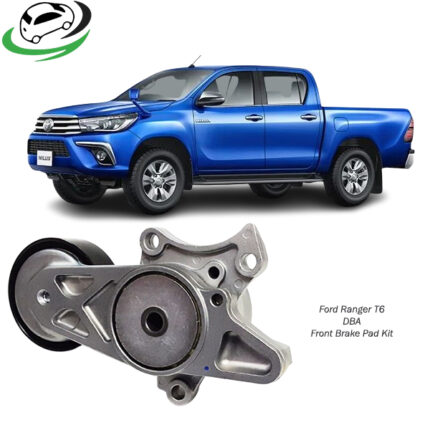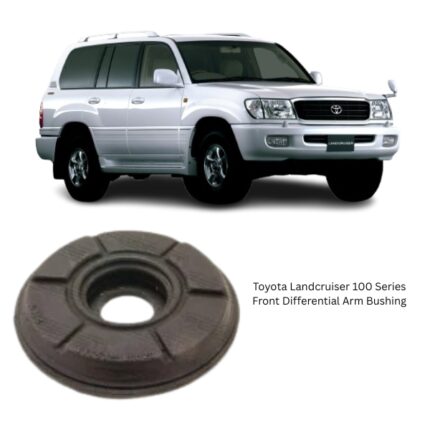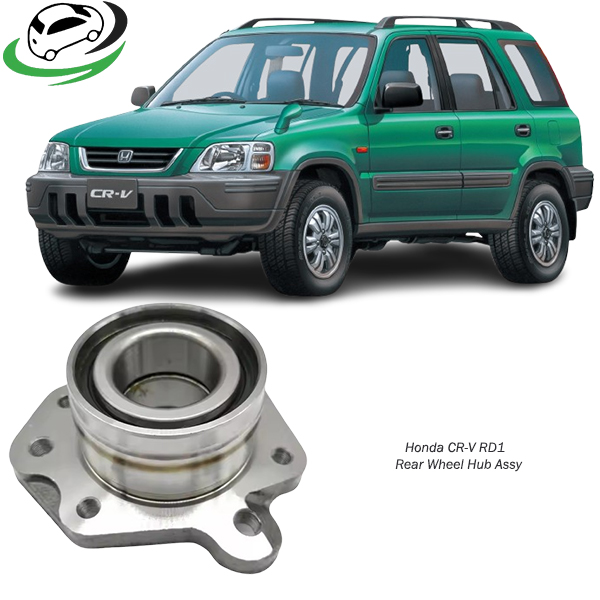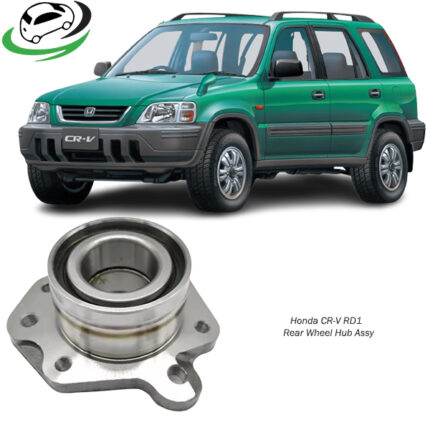Get Honda CR-V RD1 Rear Wheel Hub Assy BEL 42201-S10-A01 in Kenya
The wheel hub assembly is a crucial component in a vehicle’s suspension and drivetrain system, responsible for mounting the wheel and allowing it to rotate freely. It integrates several essential elements that contribute to the vehicle’s stability, safety, and overall performance. This comprehensive guide explores the wheel hub assembly in detail, covering its definition, components, function, types, working mechanism, maintenance, common issues, and importance in vehicle operation.
Definition and Components
Definition
The wheel hub assembly is a critical component located at the center of each wheel, connecting the wheel to the vehicle’s suspension system. It houses the wheel bearings, hub, and sometimes the wheel studs or bolts, allowing the wheel to rotate smoothly while supporting the vehicle’s weight.
Components
- Hub: Central component to which the wheel bolts or studs are attached. It mounts securely to the vehicle’s suspension.
- Wheel Bearings: Bearings mounted within the hub that allow the wheel to rotate smoothly with minimal friction. They can be either ball bearings or roller bearings, depending on the vehicle’s design.
- Seals: Prevent contaminants such as dirt and water from entering the wheel bearings, helping to maintain their integrity and longevity.
- Wheel Studs or Bolts: Attach the wheel to the hub assembly. Wheel studs are common in many vehicles, while bolts are used in others.
- ABS Sensor (if equipped): Monitors the rotational speed of the wheel. This data is used by the vehicle’s ABS and traction control systems for optimal braking and stability control.
Function and Working Mechanism
Function
The primary function of the wheel hub assembly is to support the vehicle’s weight and facilitate smooth rotation of the wheels. It allows the wheels to rotate independently while transmitting driving torque and braking forces from the axle to the wheels.
Working Mechanism
- Support and Rotation: The hub assembly supports the weight of the vehicle and provides a stable mounting point for the wheel. It allows the wheel to rotate freely with minimal friction, thanks to the wheel bearings housed within the assembly.
- Transmission of Forces: During vehicle operation, the wheel hub assembly transmits driving torque from the axle to the wheels, allowing the vehicle to move forward or backward. It also transfers braking forces from the brake system to the wheels, enabling effective braking.
- ABS Functionality (if equipped): In vehicles equipped with ABS, the wheel hub assembly houses an ABS sensor. This sensor detects the rotational speed of the wheel and sends this information to the vehicle’s ABS and traction control systems. It helps prevent wheel lock-up during braking and enhances vehicle stability and control.
Types of Wheel Hub Assemblies
Integrated Wheel Hub Assembly
- Contains the wheel bearings, hub, and sometimes ABS sensor in a single unit. It is pre-assembled and typically replaced as a complete unit when worn or damaged.
Non-Integrated Wheel Hub Assembly
- Consists of separate components such as the hub, wheel bearings, and ABS sensor. These components are individually serviced or replaced as needed.
Serviceable vs. Non-Serviceable
- Some wheel hub assemblies are designed to be serviceable, allowing for replacement of wheel bearings or seals without replacing the entire assembly. Non-serviceable assemblies require replacement of the entire unit if any component fails or wears out.
Importance in Vehicle Operation
Safety and Stability
The wheel hub assembly plays a critical role in ensuring vehicle safety and stability. By supporting the wheel and allowing it to rotate smoothly, it maintains proper alignment and control during acceleration, braking, and cornering maneuvers.
Smooth and Quiet Operation
High-quality wheel bearings within the hub assembly reduce friction and noise, providing a smooth and quiet ride for vehicle occupants. This enhances driving comfort and reduces vibration transmitted to the vehicle chassis.
ABS and Traction Control Functionality
In vehicles equipped with ABS and traction control systems, the wheel hub assembly’s ABS sensor provides crucial data on wheel speed. This information enables the ABS system to modulate braking pressure and prevent wheel lock-up, enhancing braking performance and vehicle stability in various road conditions.
Load-Bearing Capacity
The wheel hub assembly supports the weight of the vehicle and withstands forces transmitted during acceleration, braking, and uneven road surfaces. Its robust design and materials ensure reliable performance under varying load conditions.
Maintenance and Inspection
Regular Inspection
Periodically inspect the wheel hub assembly for signs of wear, damage, or contamination. Check for excessive play or noise when rotating the wheel by hand, which may indicate worn wheel bearings or hub issues.
Wheel Bearing Maintenance
Follow manufacturer recommendations for wheel bearing maintenance, such as lubrication intervals or replacement schedules. Proper lubrication and maintenance help extend the lifespan of wheel bearings and prevent premature wear.
ABS Sensor Maintenance (if equipped)
Keep the ABS sensor and its mounting area clean and free of debris. Inspect the sensor wiring for damage or wear, as faulty sensors can affect ABS and traction control system functionality.
Seal Inspection and Replacement
Inspect wheel hub seals for signs of leaks or damage. Replace damaged seals promptly to prevent contaminants from entering the wheel bearings, which can cause premature wear or failure.
Professional Service
If you suspect issues with the wheel hub assembly, such as abnormal noise, vibration, or handling characteristics, have the vehicle inspected by a qualified mechanic. Prompt diagnosis and repair can prevent further damage and ensure safe vehicle operation.
Common Issues and Symptoms
Grinding or Growling Noise
Worn or damaged wheel bearings within the hub assembly can produce a grinding or growling noise, especially during vehicle acceleration or deceleration. This indicates insufficient lubrication or bearing wear.
Wheel Play or Wobble
Excessive play or wobble in the wheel when jacked up or while driving may indicate worn or loose wheel bearings, hub issues, or a failing ABS sensor. This can affect vehicle stability and handling.
ABS Warning Light
An illuminated ABS warning light on the dashboard may indicate a fault with the ABS sensor located within the wheel hub assembly. Diagnostic scanning can identify the specific issue affecting ABS system functionality.
Uneven Tire Wear
Worn or damaged wheel bearings or hub components can cause uneven tire wear patterns. Inspect tires regularly for signs of abnormal wear, such as cupping or feathering, which may indicate suspension or wheel hub issues.
Excessive Heat or Overheating
Overheating of the wheel hub assembly, noticeable by touch after driving, may indicate friction due to inadequate lubrication or excessive load. Address overheating issues promptly to prevent bearing damage or failure.
Follow us on Facebook for more parts.




